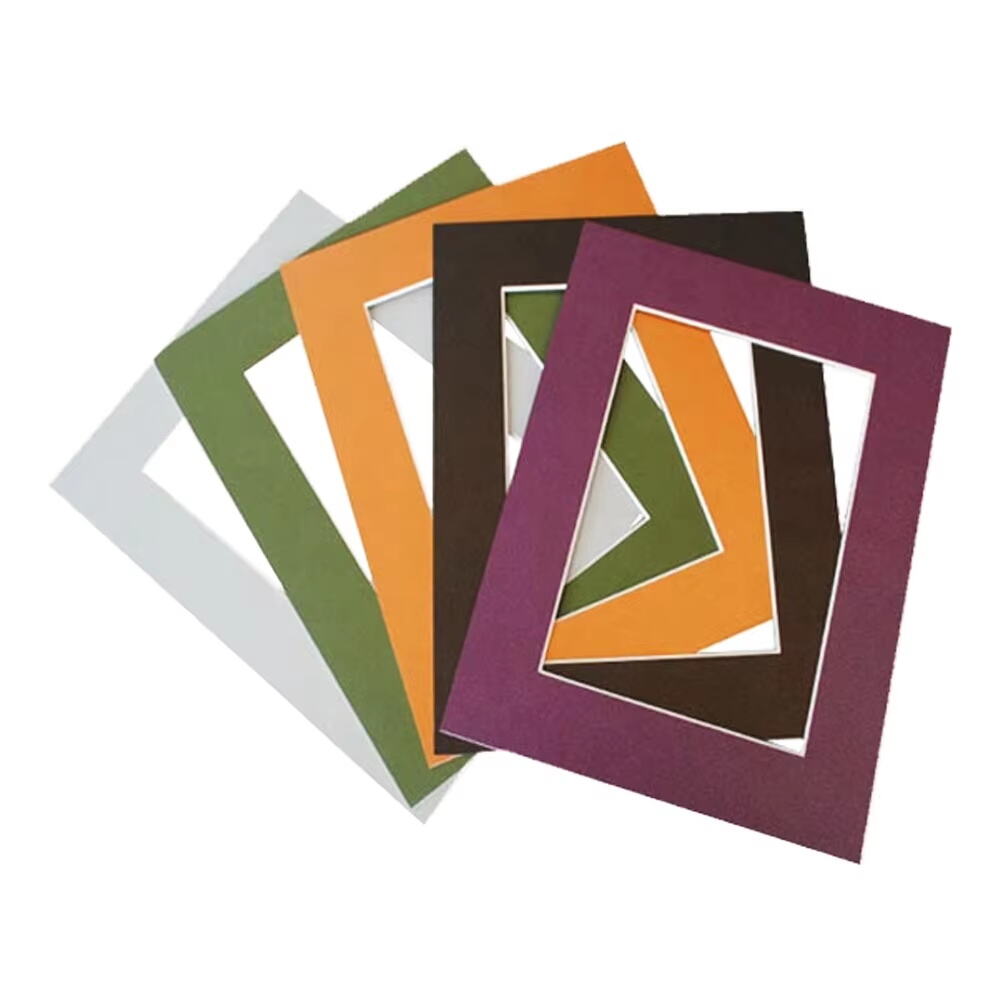그림 액자에서 무산성 매트 보드 소개
미술 작품과 사진의 보존에는 무산성 매트가 필수적입니다. 풍경 인쇄물, 미술작품, 심지어 개인 기념품인 그림, 의미 있는 사진 또는 기념물에도 사용하는 액자 재료는 이러한 아이템을 보존하고 전시하는 데 있어 얼마나 오래 지속될 수 있을지 그리고 시각적인 외관에 큰 영향을 미칩니다. 무산성 매트 보드는 우리가 소중히 여기고 집에 전시하는 모든 추억을 보존하는 데 중요한 부분이지만, 귀중한 추억을 효과적으로 보호하려면 매트 보드가 어떻게 무산성이 되는지와 그 과학적 원리인 pH 중립성에 대해 조금 알아야 합니다.
무엇이 매트 보드를 산성 없게 만드나요?
킹 사이즈 포토 매트는 액체 프레임 작업에서 예술 작품과 사진을 화학 반응으로 인해 시간이 지남에 따라 변색될 수 있는 손상으로부터 보호하기 위해 산성 없는 소재로 제작됩니다. 이러한 보드는 강idity와 안전성 등의 자연적인 특성을 가진 면 직물이나 특수 정제된 목재 펄프로 만들어졌습니다. 따라서 여기서 언급되는 것은 pH가 아니라, 많은 물질들이 중성 지점을 유지하도록 도와주는 버퍼링 에이전트를 포함하고 있다는 점이 분명합니다. 일반적으로 이들의 pH는 최소 7 이상입니다. 이러한 매트 보드들은 적절한 pH 수준을 제공하며, 업계에서 인정받은 두 가지 시험 방법 중 하나에 따라 보드의 pH가 8.0보다 낮지 않고 9.5보다 높지 않도록 시험됩니다. 우리는 산성 없는, 버퍼 처리된 재료를 사용하여 귀중한 예술 작품과 사진을 노란색 변색 및 산에 의한 손상으로부터 보호할 수 있습니다.
PH 중립 재료의 과학
PH-중성 물질이 사용된 무산(mat) 보드의 산도 조절 과학에 대해 배우게 될 것입니다. 산성 성분은 시간이 지남에 따라 미술품과 사진이 훼손되는 원인이 되며, 종이가 노랗게 변색되고 인쇄물의 색상이 바래게 됩니다. 하지만 pH-중성의 무산 보드를 사용함으로써 이러한 위험을 크게 줄일 수 있습니다. 과학적으로도 예술 작품을 올바르게 마운트(고정)할 때 pH-중성 접착제와 테이프, 무산 보드를 사용하는 것이 필요하다는 것이 입증되었습니다. 이러한 자재들은 단순히 장식적인 경계선을 제공하는 것이 아니라, 분해와 함께 일반적으로 발생하는 화학 반응을 멈춤으로써 해당 물건이 오랫동안 보존될 수 있도록 보장합니다. 따라서 소중한 액자 작품을 수년간 보존하려면 pH-중성 자재를 사용하는 것이 중요합니다.
산기 없는 보호로 작품 수명 연장
산성 재료가 어떻게 훼손을 가속시키는지
산성 프레이밍 재료의 유해한 영향은 예술 작품의 가속화된 훼손과 미적 및 구조적 완전성의 손실에 기여할 수 있습니다. 예술 작품의 훼손은 pH 산성 프레이밍 재료로 직접적으로 추적될 수 있으며, 이는 빠른 분해의 원인이 됩니다. 이는 대부분의 종이에 포함된 산이 예술 작품으로 이동하여 노란색 변색과 영구적인 훼손을 일으킬 때 발생합니다. 또한 보존 과정에 기여하는 환경 조건을 염두에 두는 것이 중요합니다. 온도와 습도의 영향: 이러한 손상은 온도와 습도 같은 기후 요인에 의해 증가될 수 있으며, 이는 화학적 공격을 촉진할 수 있습니다. 이러한 보다 포괄적인 지식은 이러한 귀중한 물체를 프레이밍하고 보관하기 위한 가장 적절한 재료와 조건을 결정하는 데 도움을 줍니다.
고약화 방지 및 섬유 파괴 방지
작품의 섬유를 보호하고 부서짐을 방지하기 위해 보존용 매트를 사용해야 합니다. 특히 종이 기반 예술에서는 무산성 소재가 빛, 습기 및 대기 오염물질로 인한 훼손 효과로부터 질감과 선명도를 보호하는 버퍼 역할을 하며, 잉크의 안정적인 종이 위 인쇄에도 도움을 줄 수 있습니다. 또한 전문가들은 작품을 더 잘 보호하기 위해 정기적으로 프레임을 점검하고 교체하는 것이 좋은 관행이라고 조언합니다. 이 예방 조치는 무산성 재료가 제공해야 할 보호력을 감소시킬 수 있는 환경 요인에 대한 장시간 노출을 방지하는 데 도움을 줍니다. 무산성 매체를 선택할 때 우리는 단순히 작품의 현재 모습뿐만 아니라 그 지속 가능한 영향까지 고려하고 있는 것입니다.
수십 년 동안 색상 일체성 유지
인접한 자료의 노란 변색 차단
산성 없는 보드 산성 없는 매트는 시간이 지남에 따라 프레임된 인쇄물의 생동감을 유지하는 데 중요한 자산이며, 인접한 재료가 노랗게 변하는 것을 방지하는 데도 도움이 됩니다. 작품의 노란 변색은 거의 발생하지 않으며, 산이 이미지 근처의 다른 요소로 이동하지 않기 때문입니다. 색상 변화율에 대한 연구들은 산성 없는 재료로 만든 매트 보드를 사용할 경우 가속 테스트에서 측정했을 때 보호 글레이징 없이도 100년 이상 예술 작품의 색상 변화가 거의 없다는 것을 보여주었습니다. 우리의 제품에는 포함되지 않았지만요. 따라서 오랫동안 선호하는 아이템의 미적 가치를 유지하려면 장기적인 색상 효과가 있는 적절한 재료를 선택하는 것이 중요합니다.
자외선 저항 및 페이드 방지
"산성 없는 매트 보드를 사용하고 UV 차단 유리나 아크릴과 결합하면 색상 손실을 크게 줄일 수 있다"고 말하며, 이는 시간이 지남에 따라 빛의 영향으로부터 액자 안의 작품들을 보호합니다. 이 칵테일은 헤어가 더 건강한 외관을 가지도록 도와주고 태양의 손상으로부터 UV 보호를 제공하여 탄력 상실 또는 심지어 색상 퇴색까지 방지합니다. 시장 조사는 UV 보호 기능이 있는 액자 선택이 예술 작품의 전체 색상 수명을 크게 연장시킨다는 것을 확인했습니다. 또한 UV 노출로 인해 발생할 수 있는 잠재적인 피해를 이해하는 것이 중요하므로, 장기적인 보호를 보장하는 적절한 액자 재료를 선택해야 합니다. 이러한 보호는 우리의 소중한 추억과 예술 작품들이 세대를 통해 그 가치와 미적 매력을 유지할 수 있도록 해줍니다.
다양한 미디어 예술의 안전한 보존
사진 에멀전과 반응하지 않음
산성 없는 매트 보드의 가장 큰 장점 중 하나는 일반 카드보드와 달리 사진과 화학 반응이 일어나지 않는다는 것입니다. 이는 사진의 수명 동안 사진의 선명도를 유지시켜줍니다. 대부분의 연구에 따르면 산성 없는 프레임 처리된 사진은 전통적인 재료로 프레임 처리된 사진보다 훨씬 적은 손상 수준을 나타냅니다. 실제로 사진 보존 전문가들은 이러한 산성 없는 구성 요소 없이는 사진이 언젠가는 희미해지거나 색이 변하며 곰팡이가 생길 수 있다고 강력히 권고합니다. 따라서, 산성 없는 매트 보드는 사진의 품질과 내구성을 수년간 그리고 후대에 걸쳐 유지하려는 사람들에게 필수적입니다.
수채화 및 유기 잉크 보호
또한, 산성 없는 매트 보드는 수채화와 유기 잉크를 보존하는 데에도 중요하며, 섬세한 유기 소재를 그대로 유지시킵니다. 그 특별한 기능은 시간이 지남에 따라 수채화에서 발생할 수 있는 번짐과 퇴색을 방지하여 작품을 보호합니다. 보존 전문가들은 완벽한 프레이밍 과정이 산성 없는 재료의 사용을 필요로 한다고 말하며, 이는 원래 이미지의 진짜 색상과 품질을 유지하기 위함입니다. 산성 없는 매트 보드를 선택함으로써 예술가들과 수집가들은 자신의 작품이 마땅히 받아야 할 보호와 안정성을 받을 수 있다는 확신을 가질 수 있습니다. 이러한 보호는 예술의 미적 가치뿐만 아니라 경제적 측면까지 감안합니다.
예방 관리를 통한 비용 효율적인 프레임
복원 비용 절감
산성 없는 매트 보드를 구입하는 것은 복원 비용을 절감하고 치료 비용을 줄이는 데 도움이 되는 현명한 투자입니다. 산성 없는 재료는 작품이 퇴색하거나 분해되는 것을 방지하여 고가의 복원된 작업을 보호하기에 적합합니다. 재정 분석 결과, 최고의 재료를 사용하여 액자를 제작하는 비용은 시간이 지남에 따라 저질 산성 소재로 인해 발생하는 손상을 복구하려는 비용에 비해 매우 작은 부분임을 보여줍니다. 업계 전문가들은 산성 없는 재료를 사용하는 것을 권장하며, 보존 및 복원 비용 측면에서 상당한 금액을 절약할 수 있다고 강조합니다. 이러한 예방 조치는 선호하는 그림의 수명을 연장할 뿐만 아니라 장기적으로 비용도 절감시킵니다.
수집가들을 위한 장기적 가치
예술 수집가들에게 이는 그들의 소장품에 대해 큰 장기적 가치를 제공합니다. 산성 물질이 없는 재료로 작품을 마트링 및 마운팅하는 경우, 작품의 시장 가치 상승률이 더 높은 것으로 나타났으며, 수집가와 투자자들뿐만 아니라 고품질 보존을 추구하는 사람들에게도 더욱 매력적으로 작용합니다. 이러한 이유로 해당 작품들이 시장에서 보다 적극적으로 거래되며, 이는 곧 수집가들에게 더 나은 투자 수익을 가져다줍니다. 이러한 개념은 시장 동향에서도 뒷받침되고 있으며, 보존 가치를 중시하고 무산성 액자 제품에 투자하는 수집가들은 경제적 이익을 얻을 가능성이 더 높다는 것을 보여주고 있습니다. 이는 예술 작품의 즉각적인 보존뿐 아니라 장기적인 금전적 가치를 위해서도 무산성 자재를 사용해야 할 필요성을 강조합니다.
자주 묻는 질문
사진 액자 제작에서 무산성 재료를 사용하는 것이 중요한 이유는 무엇인가요?
장기 보존을 위해 예술 작품과 사진은 산성 없는 재료를 사용하는 것이 필수적입니다. 이러한 재료는 노화, 누렇게 변色 및 색상 변화를 일으키는 화학 반응을 방지하는 데 도움을 줍니다.
산성 없는 마트 보드는 어떻게 UV선으로부터 예술품을 보호합니까?
UV 차단 유리나 아크릴과 함께 사용할 경우, 산성 없는 마트 보드는 시간이 지남에 따라 퇴색과 색상 손실을 방지하여 UV선으로부터 보호합니다.
수집가들이 왜 산성 없는 마트 보드에 투자해야 합니까?
산성 없는 마트 보드는 보존을 확실히 하고, 예술품의 장기적인 가치를 증대하며, 고급 보존을 중시하는 구매자를 끌어들입니다.
산성 없는 매트 보드가 종이 기반의 미술 작품의 부서짐을 예방할 수 있나요?
네, 산성 없는 재료는 섬유를 안정화시켜 부서짐을 줄이고 환경적 요인들로부터 작품의 질감과 선명도를 보존합니다.

